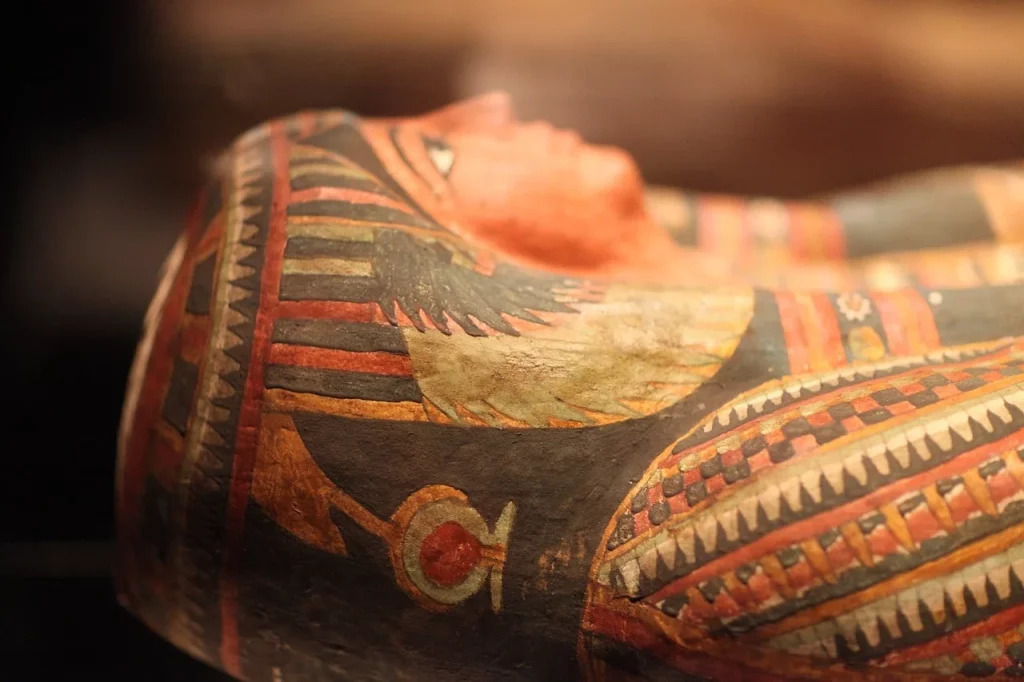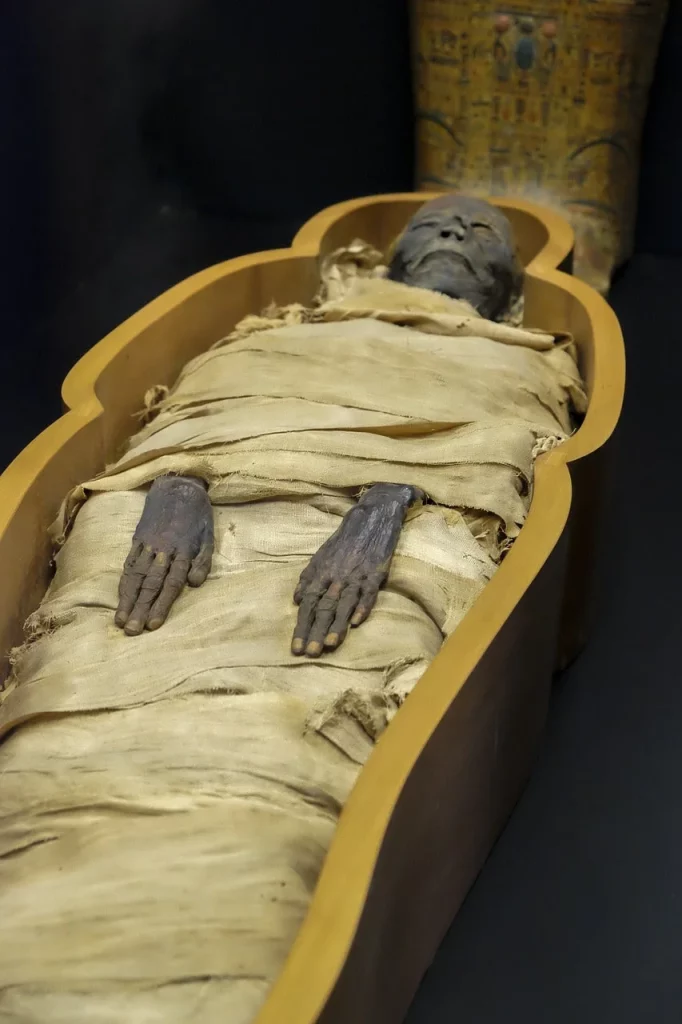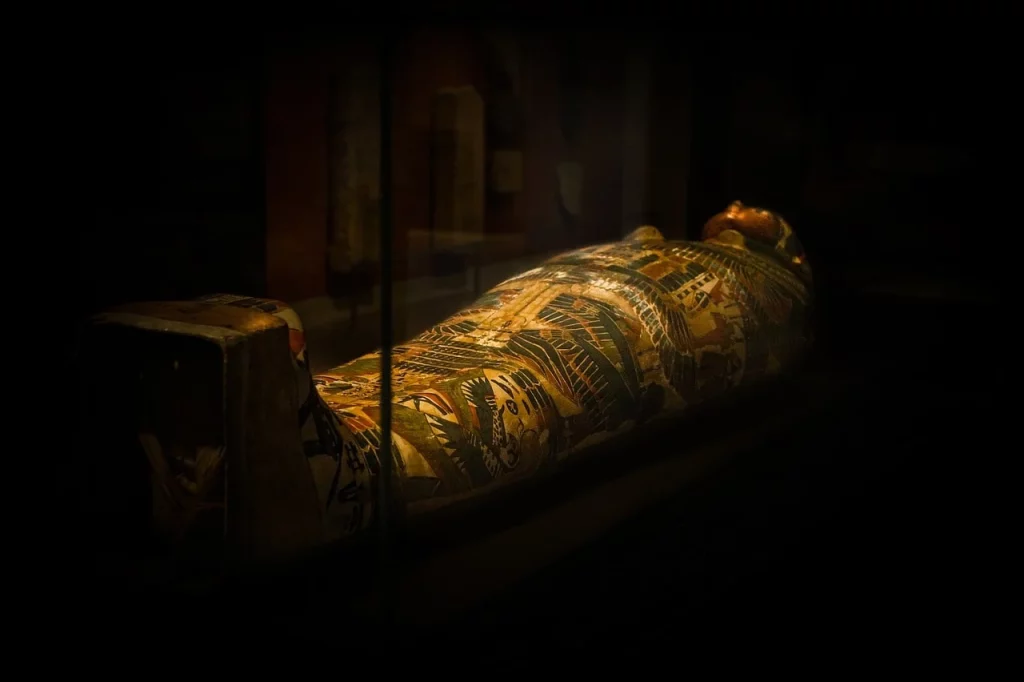Mummies: They’re not just in horror movies. In fact, these ancient, preserved bodies hold the keys to understanding civilizations long gone. From the elaborate embalming methods of the Egyptians to the natural preservation found in bogs, mummies provide a fascinating glimpse into the past.
Today, we’re diving into some incredible mummy facts that will give you a peek into their world. Whether you’re a history buff or just curious, these facts will amaze and enlighten you.
Mummies are like time capsules, preserving the mysteries of the past for us to unravel.
Neil deGrasse Tyson
Mummy Facts
Jump into the world of mummies, a topic rich with history and mystery. As you absorb each fact, keep in mind that a quiz at the article’s end will test your expertise. Don’t disappoint me.
- The oldest known intentionally created mummies are not from Egypt but from the Chinchorro culture in South America, dating back to around 5050 B.C.
- Not all were royalty; in ancient Egypt, many pets and sacred animals were also mummified.
- Some mummies have been found with heart scarabs placed over their hearts, intended to prevent the heart from confessing sins.
- Mummification recipes varied over time, with some mixtures so effective that mummies still retain their hair and nails thousands of years later.
- The brain was often removed through the nose using a hook-like tool during the mummification process.
- Tattoos have been found on some Egyptian mummies, suggesting a practice of body art thousands of years old.
- The Valley of the Kings is a famous burial site, yet it still reveals new secrets and tombs despite centuries of exploration.
- X-rays and CT scans of mummies have revealed diseases such as arthritis and dental problems, showing that ancient people suffered from similar ailments as we do today.
- Some mummies were made with artificial eyes, often crafted from enamel or stone, to make them appear more lifelike.
- Mummification techniques spread across the globe, with examples found in China, Europe, and the Canary Islands, each region having its own unique method.
- Workers involved in the mummification process often lived apart from society due to the sacred and unclean nature of their work.
- Mummy brown was a pigment used in European art that was actually made from ground-up mummies.
- Contrary to popular belief, not all mummies are wrapped in linen; some are encased in resin or bitumen.

- The Guanche people of the Canary Islands also practiced mummification, using techniques similar to those of the ancient Egyptians.
- Pliny the Elder wrote about mummification, showing that even in ancient times, the process fascinated people outside of Egypt.
- Some Victorian-era parties featured the unwrapping of Egyptian mummies as entertainment.
- Mummies have been found with perfectly preserved clothing, including sandals and jewelry.
- The practice of making mummies persisted into the Christian era in Egypt, showing a blend of old customs with new beliefs.
- Medical studies on mummies have contributed to our understanding of ancient diets and health, showing high grain diets and sometimes evidence of famine or malnutrition.
- Mummification wasn’t exclusive to humans; cats, crocodiles, and even birds were mummified.
- Natural mummies have been discovered in deserts and glaciers, preserved by the extreme conditions.
- The oldest known anthropogenic mummy was a child found in the Andes, preserved for over 5000 years.
- The Egyptian Book of the Dead contained spells and instructions to help the deceased navigate the afterlife.
- Mummies have been found wearing elaborate masks and coffins painted with scenes from the deceased’s life and beliefs.
- In some cases, false doors were carved into tombs as a portal for the deceased’s spirit to enter and exit the afterlife.
- Mummification was an expensive process, often reserved for the wealthy or noble.
- Amulets were placed among the wrappings for protection and to grant the deceased power in the afterlife.
- Researchers use DNA analysis to study mummies, revealing information about ancient family ties and genetic diseases.

- Some ancient tombs contain murals that depict the mummification process, offering insights into the techniques used.
- The study of mummies has its own scientific term: paleopathology.
- Several mummies have been found with evidence of heart disease, challenging assumptions about ancient lifestyles.
- Mummies have been discovered with their organs preserved in canopic jars, each dedicated to a specific god.
- The Rosicrucians claim to have a secret mummification technique, reviving interest in ancient methods.
- In addition to humans and animals, food items and grains were also mummified as offerings to the dead.
- Mummies from the Andes are often found in a fetal position, reflecting local beliefs about rebirth and the afterlife.
- The practice of mummification highlights a universal concern with death and the afterlife across various cultures.
- Mummies in medieval European crypts were naturally preserved by cool, dry air, showing a different form of mummification.
- The discovery of Ötzi, the Ice Man, offered unprecedented insights into the life of a man who lived over 5,000 years ago.

- Some mummies still have intact blood cells, allowing scientists to study ancient diseases.
- Electricity was used in the 19th century in attempts to reanimate Egyptian mummies, inspired by tales like Frankenstein.
- The Chinese Tarim mummies have European features, suggesting a diverse and interconnected ancient world.
- Mummies have been used in medicine, ground up as powders thought to have healing properties.
- The process of mummification could take up to 70 days, involving drying, embalming, and wrapping phases.
- Experimental archaeology involves recreating mummification techniques to understand ancient practices better.
- Despite the Egyptian climate being ideal for mummification, sophisticated methods have been developed to improve preservation.
- Historical accounts of mummies helped spark a wave of Egyptomania in Europe, influencing art, architecture, and literature.
- The first recorded autopsy of a mummy was conducted by Napoleon’s scientists during the Egyptian campaign.
- In addition to spiritual reasons, mummification had practical aspects, such as legal identification and property rights in the afterlife.
- Some mummies have been found with intricate hairstyles, including braids and wigs, which offer insights into the fashion and social status of the time.
- The practice of mummification also led to the world’s earliest forms of cryptography, as certain spells and texts were encoded to protect their sacred knowledge from the uninitiated.
Mummy Myths

Having wrapped up the facts about mummies, it’s time to unravel the myths. Let’s find out the actual truth behind some common myths.
- Mummies Are Cursed
The curse of the mummies, especially that of Pharaoh Tutankhamun, is a popular tale. However, it has been debunked by experts. It’s believed that these stories were sensationalized by the media. Scientifically, no evidence supports curses being real. The deaths linked to the curse are often attributed to natural causes or coincidence. - Mummies Are Only Found in Egypt
While Egypt is famous for them, the practice of mummification is used around the world. They have been found in South America, Asia, and even Europe. Different cultures mummified their dead due to various beliefs about the afterlife and the importance of preserving the body. - All Mummies Were Pharaohs or Royalty
It’s a common misconception that only the rich and powerful were mummified in ancient societies. In reality, mummification was not exclusive to royalty. Many ordinary people, especially in later periods of Egyptian history, were also mummified, although the quality of mummification varied according to wealth and social status. - Mummies Were Made by Removing All Organs
The process of mummification did involve removing internal organs, but not all were taken out. The heart was often left inside the body because it was considered the center of intelligence and emotion. Other organs like the liver, lungs, stomach, and intestines were removed, treated, and placed in canopic jars. - Mummies Are Always Human
When we think of mummies, human mummies usually come to mind. However, many animals were also mummified in ancient cultures. In Egypt, cats, dogs, crocodiles, and birds were mummified for religious reasons, either as offerings to the gods or as pets meant to accompany their owners into the afterlife.
No products found.
Mummy Quotes

Prepare to be transported across time as we delve into a collection of quotes that illuminate the awe, curiosity, and even fear these figures inspire.
The best way to understand the living is to study the dead.
Carl Sagan
Carl Sagan emphasizes the importance of studying mummies and other archaeological findings to gain insights into human history and evolution.
Mummies, to me, are fascinating because they are a direct link to our past.
Zahi Hawass
Zahi Hawass, an Egyptologist, expresses his fascination with mummies for providing a tangible connection to history and ancient cultures.
Unraveling a mummy is like reading a book from the past.
Elizabeth Peters
Elizabeth Peters, an author known for her archaeological mysteries, compares the process of examining mummies to uncovering stories and secrets from history.
Each mummy has a story to tell, silent yet eloquent.
Joyce Tyldesley
Joyce Tyldesley, a British archaeologist and Egyptologist, points out that mummies, though silent, have powerful stories about the people and societies they come from.
The allure of mummies lies not in their appearance but in the stories they carry across millennia.
Zahi Hawass
Here, Hawass articulates the deep fascination with mummies, emphasizing that their true value lies in the stories and knowledge they preserve over thousands of years.
Mummy FAQ

We continue to the last section before the trivia. Read these answers carefully if you want to have a perfect score.
- Are mummies real?
Yes, they are real! They are the preserved remains of humans or animals. This preservation can happen either naturally, through extreme conditions like cold or dryness, or through intentional embalming practices, such as those used by the ancient Egyptians. - Were mummies buried alive?
No, the mummification process was performed on the deceased. The idea that people were mummified alive is a myth. Ancient cultures, especially the Egyptians, treated death with great care and respect, performing rituals and embalming the dead to prepare them for the afterlife, not burying them alive. - How old is the oldest mummy?
The oldest mummies that have been discovered date back to around 5000 BCE and were found in the Atacama Desert of South America. These predate the Egyptian mummies by a couple of thousand years, showing that the practice of mummification was widespread and not exclusive to Egypt. - Can mummies curse people?
The “curse of the pharaohs” is a popular legend, suggesting that those who disturb a mummy’s tomb will suffer bad luck or death. However, there is no scientific evidence to support the existence of such curses. These stories are often attributed to media sensationalism or ancient warnings meant to deter tomb robbers. - Are there mummies outside of Egypt?
Yes, they have been found all over the world, not just in Egypt. Various cultures practice mummification, including in South America, where the Chinchorro mummies are considered some of the oldest. There are also natural mummies, created in environments that prevent decomposition, found in Europe, Asia, and North America.
No products found.
Mummy Trivia

Welcome to our mummy quiz! If you fail to unwrap the correct answers, be prepared to spend the next thousand years trapped in a sarcophagus of confusion.
Conclusion
The study of mummies unravels the mysteries of the ancient world, showing us the sophistication of early civilizations. From the embalming methods to the rituals performed, every step was a blend of science and spirituality.
These preserved individuals offer a snapshot of their time, providing clues to their lives and deaths. They are not just remnants of the past; they are storytellers, holding within them the keys to understanding human history and civilization. Till next time, stay curious. Cheers.
2 Sources Used For This Article

